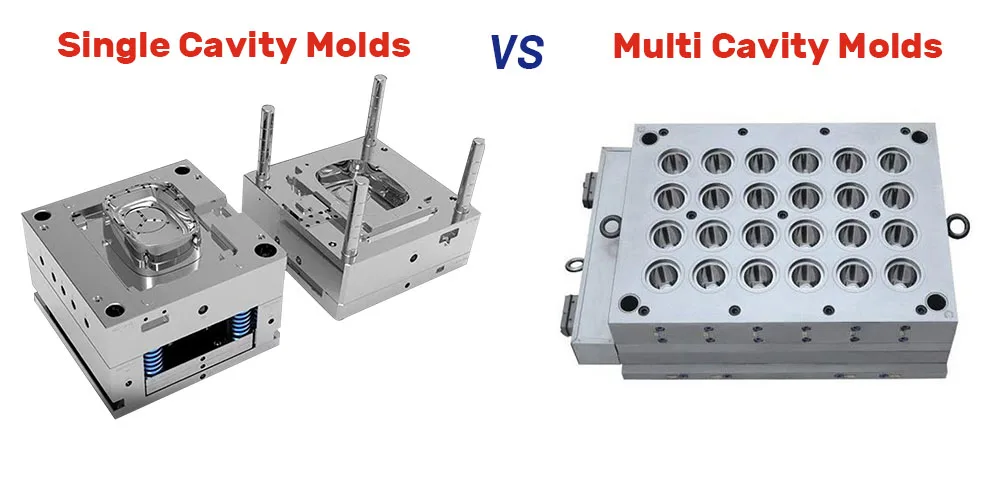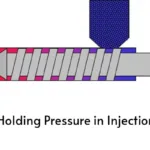Single Cavity and Multi Cavities Molds, Choosing the Right Type
May 28, 2024
Single cavity and multi cavity molds are two distinct types of injection molds used for manufacturing plastic parts. These molds are the foundation for producing various products, ranging from simple components to complex parts. In manufacturing, the choice between single-cavity and multi-cavity molds is important. This post will explore the differences between single-cavity and multi-cavity molds, comparing their advantages, disadvantages, and suitability for various manufacturing sections.
What are Single Cavity Molds?
Single cavity molds are a type of injection mold that contains only one cavity to produce a single part per molding cycle. Single cavity molds prioritize part quality over quantity. They offer tighter control, flexibility, and lower upfront costs, making them well-suited for low production volumes, complex geometries, and when design iterations are expected.
Single Cavity Molds Advantages
Lower initial tooling costs
Single-cavity molds typically require simpler designs and fewer components compared to multi-cavity molds. As a result, the initial tooling costs are often lower, making them a cost-effective option for manufacturers with budget constraints or smaller production volumes.
Easy to Control Part Quality
With only one cavity to focus on, operators have greater control over the molding process and can fine-tune parameters such as temperature, pressure, and cooling to achieve precise part dimensions and superior quality. This meticulous control ensures consistency and reliability in the finished parts.
More Flexibility for Design Changes
Single-cavity molds provide flexibility for design changes during production. Each part is made separately, allowing adjustments to the mold without disrupting the entire process. This adaptability is essential for accommodating design iterations, customer input, or unexpected production changes.
Ideal for Large Complex and High Precision Parts
Single-cavity molds are perfect for making intricate parts with precise details. Their design ensures meticulous control over part geometry, guaranteeing accurate replication of complex features and tight tolerances.
Useful for Low-volume Production
Single-cavity molds are great for small-scale production and testing, allowing for quick prototyping and adjustments. They’re perfect for making limited batches for market testing or design validation before mass production.
Multi Cavity Molds Disadvantage
While single-cavity molds offer certain advantages, they also come with several limitations and disadvantages:
Lower Productivity
Perhaps the most significant drawback of single-cavity molds is their lower productivity compared to multi-cavity molds. With only one part produced per molding cycle, the overall production output is limited, leading to longer lead times and reduced throughput.
Higher Unit Part Cost
The lower production output of single-cavity molds translates to higher per-unit costs compared to multi-cavity molds. Manufacturers may incur higher overhead costs, including labor, equipment, and overhead, which are spread across fewer produced parts, leading to increased unit costs.
Longer Cycle Times
Each part produced in a single-cavity mold undergoes the entire molding process individually, from material injection to cooling and ejection. As a result, the cycle times are longer compared to multi-cavity molds, where multiple parts are produced simultaneously in a single cycle. Longer cycle times can impede production efficiency and increase overall manufacturing lead times.
Not Suitable for High-Volume Production:
Single-cavity molds are inherently less efficient for high-volume manufacturing requirements due to their limited production output and longer cycle times. While they may be cost-effective for low to medium-volume production runs or prototyping purposes, they are not suitable for mass production scenarios where maximizing throughput and minimizing cycle times are critical.
What Is Multi Cavity Molds?
Multi-cavity molds are a type of injection mold that contain multiple identical cavities to produce multiple parts in a single molding cycle. Multi-cavity molds consist of an assembly with multiple cavities, each precisely shaped to form identical parts.
Multi Cavity Molds Advantages
Increased production efficiency:
The ability to produce multiple parts in a single cycle significantly boosts production efficiency and throughput, reducing lead times and increasing overall output.
Lower unit part cost:
With higher production volumes per cycle, the per-unit cost of each part is reduced, resulting in cost savings for manufacturers.
Shorter cycle times:
By producing multiple parts simultaneously, multi-cavity molds reduce cycle times compared to single-cavity molds, enhancing overall manufacturing efficiency.
Suitability for high-volume production:
Multi-cavity molds are ideal for high-volume production runs where maximizing throughput and minimizing per-unit costs are critical.
Multi Cavity Molds Disadvantages
Higher initial tooling costs:
Multi-cavity molds typically require more complex designs and additional components compared to single-cavity molds, leading to higher initial tooling costs.
Complexity in design and operation:
Designing and operating multi-cavity molds require careful consideration of cavity layout, gating systems, and cooling channels to ensure uniform filling and cooling across all cavities, adding complexity to the manufacturing process.
Longer Lead Times:
Multi-cavity molds take longer to produce than single-cavity molds. This results in longer lead times for initial mold delivery
Limited flexibility for design changes:
Once the mold is set up for production, making design changes or modifications can be challenging and may require significant adjustments to the mold assembly, potentially impacting production efficiency and lead times.
Consideration Factors When Choose Single Cavity and Multi Cavity Molds
When deciding between single-cavity and multi-cavity molds, manufacturers must carefully evaluate several factors to determine the most suitable option for their specific production needs.
Production volume and demand:
Single-cavity molds are ideal for low to medium-volume production runs, prototyping, and customization where flexibility and adaptability are prioritized.
Multi-cavity molds are well-suited for high-volume production requirements, where maximizing throughput and minimizing per-unit costs are critical for competitiveness.
Part complexity:
Single-cavity molds are suitable for producing large, complex, or high-precision parts that require attention to detail and customization.
Multi-cavity molds are efficient for producing high-volume smaller, simpler parts with uniform geometries.
Cycle time and lead time requirements:
Single-cavity molds typically have longer cycle times compared to multi-cavity molds due to producing one part per cycle. Manufacturers must assess whether longer lead times are acceptable for their production schedules.
Multi-cavity molds offer shorter cycle times and faster production turnaround.
Cost considerations:
Single-cavity molds may have lower initial tooling costs compared to multi-cavity molds, making them more suitable for manufacturers with budget constraints or smaller production volumes.
Multi-cavity molds offer cost savings in the long run due to higher production output and lower per-unit costs. However, they entail a higher initial investment in tooling and setup.
Flexibility for design changes:
Single-cavity molds allow greater flexibility in accommodating design changes and modifications during production runs. Manufacturers can easily adjust the mold setup without affecting the entire production process, making them suitable for iterative design processes and customization.
Multi-cavity molds are less flexible. Any modifications may require significant adjustments to the mold assembly, potentially impacting production efficiency and lead times.
Conclusion
Each mold type offers unique advantages and disadvantages, catering to different production requirements and industry demands. The choice between single-cavity and multi-cavity molds is a critical decision that significantly impacts manufacturing efficiency, productivity, and cost-effectiveness.
The decision between single-cavity and multi-cavity molds must be carefully weighed against factors such as production volume, part complexity, cost considerations, and flexibility requirements. By evaluating these factors and selecting the most suitable mold type for their specific needs, manufacturers can optimize their production processes, drive efficiency, and achieve success in the marketplace.




